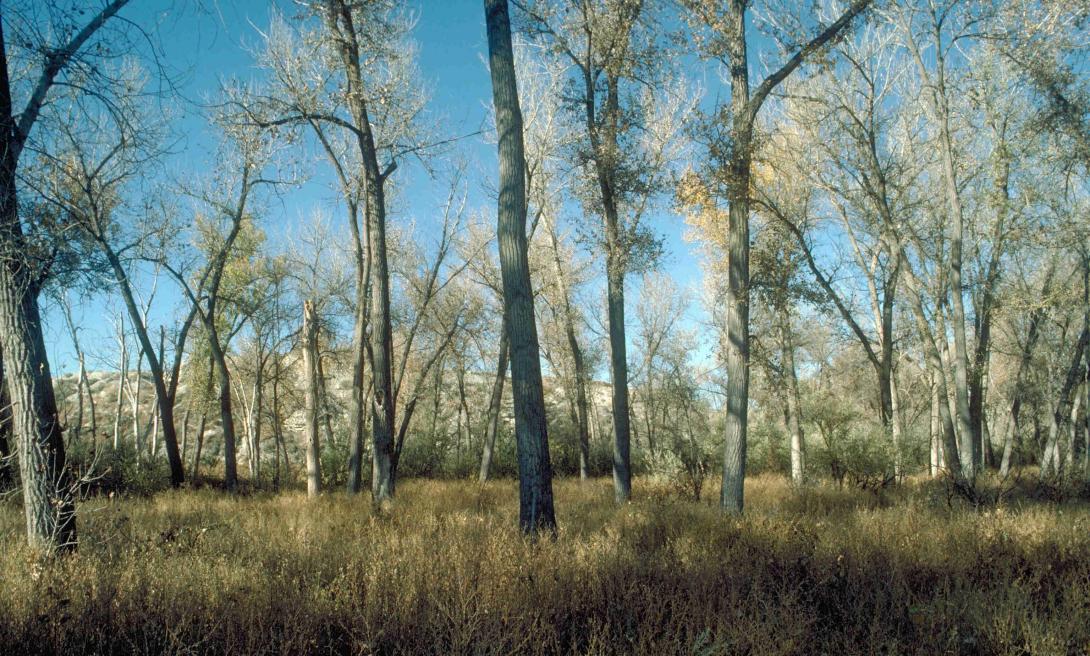Cottonwood Trees
Full Article
One of the most ecologically and culturally significant trees in Colorado, the plains cottonwood (Populus deltoides monilifera) thrives near rivers and riparian areas throughout the state. It is one of the only tree species to grow on Colorado’s Great Plains, which made it an important source of forage, fuel, timber, and medicine for Indigenous people, Hispanos, and white immigrants. The cottonwood gets its name from the millions of cotton-like seeds that female trees release each spring.
Description
Cottonwoods are tall, deciduous trees commonly found along riverbanks and other high-moisture areas, with broad leaves and dark gray bark. They thrive at altitudes of 3,500 to 6,500 feet and reach a maximum height of around 190 feet.
Seeding and sprouting are the cottonwood’s two major avenues of reproduction. Cottonwoods are dioecious, meaning individual trees are either male or female. Females grow necklace-like strings of seedpods that release millions of white, cottony seeds into the air, typically in June. Males grow purple flowers. Like their mountain-dwelling cousins the aspen, cottonwoods are members of the poplar family, but unlike the aspen, cottonwoods do not produce clone trees from a single root system. However, like other poplars, cottonwoods will readily resprout if broken or cut down—a trait that has coevolved with breaking and browsing animals such as beaver, bison, and horses.
Cottonwoods live just over 100 years—a fairly short lifespan for a tree. Sometimes large branches and the inner core of the tree will die before the rest of it, contributing to its common half-dead appearance. Cottonwoods in this condition represent a hazard, as branches can break and fall at any moment.
Ecology
As the vertical sentinels of the largely horizontal plains, cottonwoods provide habitat and food for many animals, from bison to birds, squirrels, and ponies. Eagles, blue jays, magpies, and woodpeckers are among the avian species that find respite in the cottonwood’s branches. Beaver stimulate cottonwood growth by gnawing down trunks, and bison, horses, and ponies eat the tree’s bark. Smaller trees, including willow and box elder, and shrubs thrive in the shade produced by the cottonwood.
Indigenous Culture
Indigenous people who lived on the plains and in the southwest part of the state—including the Apache, Arapaho, Cheyenne, Comanche, and Navajo—revered the cottonwood as a source of medicine and for its many practical uses, especially forage and food for horses. Sun Dance artifacts were carved from cottonwood. Perhaps the most famous grove of cottonwoods in the state was the Big Timbers, a thick stand along the Arkansas River in southeast Colorado. In the early 1800s, the Cheyenne and Arapaho fought the Comanche and Kiowa for control of the sacred grove, with all four nations brokering a peace in 1840. Meanwhile, an old, thick cottonwood along the Cache la Poudre River near present-day Fort Collins served as a Council Tree, a meeting spot for a local band of Arapaho led by Teenokuhu (Friday).
In one Arapaho story, a girl named Sapana climbs a tall cottonwood into the sky itself, where she is then put to work skinning bison hides by an old man who takes the form of a porcupine. The girl is helped back to earth by a buzzard and a hawk. In return for their help, the Arapaho always left at least one bison carcass for the buzzards and hawks after their hunts.
Hispano Culture
Cottonwood trees were also a prominent part of early Hispano culture. In southern Colorado’s Purgatoire valley, members of the Catholic Penitente Brotherhood carved santos, or holy images, into cottonwood roots and trunks. In the San Luis Valley, where permanent Hispano settlements began in the 1850s, cottonwood beams supported adobe buildings, including the many iglesias and capillas—churches and chapels—established across the valley. The town and county of Alamosa were named after the Spanish word for cottonwood grove.
American Culture
In 1807 American explorer Zebulon Pike built his stockade in the San Luis Valley out of cottonwood logs. Other whites quickly realized the importance of cottonwoods when they began crossing the plains to Colorado during the Gold Rush of 1858–59. In addition to being the only fuel aside from bison droppings, cottonwoods provided shelter and food for draft animals and acted as guideposts for immigrant parties who needed to stick to the river paths, lest they become lost in the monotonous landscape of the plains. When immigrants reached the area of present-day Denver, they found building materials scarce; as such, the first house in what became Denver City, on today’s Larimer Street, was built of “round cottonwood logs” and “roofed with earth.”
One of the first editions of the Rocky Mountain News, printed on May 14, 1859, reflects white immigrants’ views of the cottonwood as part of the strikingly beautiful scenery of springtime along the eastern slope of the Rocky Mountains:
The prairies are putting on their robes of green and the bright verdure of the cottonwood and alder contrasts beautifully with the dark sombre [sic] hue of the evergreen forests.
White immigrants’ consumption of cottonwood groves only increased as more Americans traveled west over the ensuing decades. The depletion of this important resource, as well as the simultaneous and related decline of the bison, contributed to starving conditions among many Indigenous bands in the mid- to late nineteenth century.
Threats
Since they are water-loving trees, cottonwoods are especially susceptible to drought. Millions died during the 1930s drought that contributed to the Dust Bowl, and many more could be lost in the twenty-first century as a warming climate increases drought frequency and length. In addition, dams built since the beginning of the twentieth century have lowered flow rates in the South Platte, Arkansas, and other rivers, leading to a decline in cottonwood reproduction.


































































